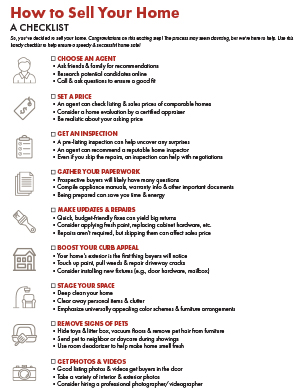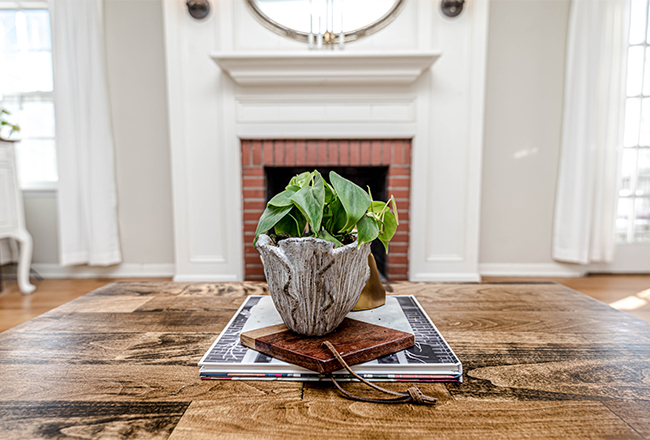
Your dream home’s calling your name, but first, you have to sell your current residence. That means you need to get your home in the best condition possible, so it appeals to more buyers as they tour the property. We all understand that a first impression is important for a job interview, but did you know it’s the same for selling your home? Luckily, there are tried-and-true things you can do to enhance the curb appeal and overall aesthetic of your home to help your buyers better envision the life they can have in the space.

Here’s a printable checklist for your convenience!
The look and feel of your home isn’t the only thing you need to think about before you take the steps to sell your home. Pricing, selecting the right real estate agent and making sure you have all the paperwork in order are also on the list. Not quite sure where to begin? Not a problem! The process may seem daunting, but we’re here to help you prepare your home for sale (and find a new one that meets your criteria!).
That’s where our handy checklist comes in! Regardless of the size, age or location of your abode, there are certain things you can do to help ensure a speedy and successful home sale. Many steps don’t cost a cent, just your time and a little research to set yourself up for success. Our checklist outlines nine simple steps to take before selling your home, townhome or condo.
So without further ado, let’s get started:
1. Choose a Real Estate Agent.
If you’re planning on buying a new construction home, ask your homebuilder if they have a program to help you sell your current home. If not, it’s time to choose a real estate agent. Ask friends and family members for referrals and take the time to interview several candidates. It’s important to select an agent who understands your home, your community and your expectations. An agent can help with everything from advertising your home and setting a fair price (see below) to scheduling showings and negotiating your sale. For more information, see Choosing an Agent to Sell Your Home: 4 Tips.
2. Set an appropriate price.
Did you know that setting the wrong price can delay your sale? You want your house to be appropriately priced so you draw in buyers who are searching for similar homes in your area. This is where choosing the right real estate agent really starts to pay off. Agents have quick access to sales data and can pull together some numbers. To help set a price for your home, your agent will conduct a market analysis of current listings and recent sales of comparable homes in your area. He or she may also request that you have your home evaluated by a certified appraiser. Factors such as your timeframe and whether or not you’re willing to make necessary repairs (see below), will also play a role in determining your asking price.
3. Get a pre-listing inspection.
Many sellers choose to have their home inspected prior to putting it on the market. A pre-listing inspection can help uncover any surprises and allow you to get estimates for repair work well before you reach the final stages of the home sale. Although this step isn’t required, it can save you a lot of time in the long run. Even if you’re unable or unwilling to make the recommended repairs, knowing how much it will cost to fix or replace faulty items (e.g., your water heater or furnace) can help during negotiations.
4. Gather your paperwork.
What is the average electricity bill for the home? What about the water? Is the dishwasher still under warranty? Buying a new home is a big commitment and prospective buyers will likely have many questions. Think of all the information you will want to know about your next new home, then compile all of your important documents, such as appliance manuals, warranty information, examples of past utility bills—even a list of the home’s paint colors—so you are able to address potential questions from prospective buyers as they arise.
5. Make updates and repairs.
While you don’t have to make any updates or repairs before you sell your home, some quick, budget-friendly fixes, such as applying a fresh coat of paint, swapping out the hardware on your kitchen cabinets, fixing that leaky faucet and replacing discolored caulking in the bathrooms, can make your abode seem fresh, functional and more modern—which may help you sell it quicker and for top dollar. As noted above, if you choose not to make even minor repairs and updates, you may have to adjust your home’s price accordingly, especially if it’s a buyer’s market. Even little things like a broken outlet cover or cobwebs can give the buyer the illusion that the house isn’t well cared for and therefore not a great investment. Don’t let the little things give the wrong impression about your home.
6. Boost your curb appeal.
Your home’s exterior is the first thing potential buyers will notice. So make sure they remember your residence for the right reasons. Touch up peeling paint, fix cracks in your driveway, pull weeds, plant flowers and, in short, do everything in your power to immediately impress house hunters. Even installing new fixtures, such as door hardware and a mailbox, can go a long way toward making a great first impression. For additional advice, see Kick up the curb appeal: 5 ways to give your home a great first impression.
7. Clean, depersonalize & declutter (a.k.a., stage).
Prospective buyers must also be able to envision themselves inside your home. The best way to achieve this is to ensure that the home is clean (hire a professional if necessary!), clutter-free (store knick-knacks and kids’ toys safely out of sight) and light on family photos and other personal items. It’s so easy to ignore clutter that you see every day, so consulting a third-party can help shed light onto the objects in your home that will get in the way of potential buyers seeing the its potential. Another wise way to win over prospective buyers? Stage the home by emphasizing stylish, universally appealing color schemes and furniture arrangements (your agent can help!). Make sure your home is ready to be viewed at all times (hint: live like you are a guest in someone else’s home) because you never know how much notice you’ll get before a showing! For additional advice, see:
- Tips for selling your home: To-do’s when putting your home on the market
More tips for preparing for the home for sale and making it look its best
- Preparing for a Move: How to Declutter & Minimize
Declutter strategies to kick off your clean out
- The Best Home Organization Resources
Resources to organize your home so buyers understand the storage possibilities
- The Importance of Home Staging
A more in-depth look at what you need to do to stage your home right
8. Remove proof of pets.
Your furbaby is an important member of the family. But not everyone loves pets, and even those who do may be hesitant to buy a home that was previously occupied by your furry, four-legged friend. So stash the chew toys, hide the litter box, vacuum the floors and remove pet hair from furniture. When it’s time for showings, you may choose to send Fido to your neighbor’s house or look into temporary doggie daycare. You may also want to invest in some vanilla-scented room deodorizer to help make your home smell fresh. And don’t forget the backyard! If the space looks ravaged by animals who dig or damage outdoor furniture, that can increase the repair budget in the minds of potential buyers. Don’t deny that you have a live-in canine companion—just demonstrate that your home is clean, move-in ready and worthy of your asking price. For more information, see Prepare a House for Sale (Despite Kids & Pets!).
9. Get fabulous photos and videos.
Everyone knows that good listing photos get buyers in the door. After all, they say a picture is worth a thousand words. Good thing as homebuilders, we know a thing or two about showcasing homes for sale and taking the best photos possible. Be sure to present your home in its best possible light with a variety of interior and exterior photos and/or a virtual home tour. Buyers may choose to skip the tour altogether on homes online that have sparse or dark photography. More buyers touring your home may mean more potential offers, so this is not a place to skimp! Many sellers choose to hire a professional photographer who specializes in home photography (ask friends, family or your real estate agent for a recommendation). Some agents even include photography as part of their service. If you are determined to take on the task yourself, see Capturing Curb Appeal: 4 Real Estate Photography Tips.
If you’ve made it to the end of this list, congratulations! You’ve done the work to make sure your home sells and you can start thinking about your next new living space. Even if you’re still working through this list, it’s never too soon to start researching floor plans and communities in the area. The prospect of a new home may even be the best motivation to getting this checklist done in record time!
When you’re ready to start that window shopping, Richmond American offers a variety of floor plans. Explore RichmondAmerican.com or call a New Home Specialist at 888.500.7060 to find the perfect community and floor plan near you!
Expert tip!
The great thing about new homes is that you won’t have to look past someone else’s clutter to envision how you will personalize your space. And you won’t have to settle for someone else’s bad taste in flooring and cabinetry! At the Home Gallery™ design center, we offer hundreds of ways to showcase your style with fixtures, finishes and flooring. Be sure to watch the video on our Design a Home page to learn more about our unique process.
Want additional tips to help sell your home? We have a whole bank of articles at your fingertips. Check out our other informative stories for sellers now.
Be the first to hear about special offers!
Stay up to date on new neighborhoods and floor plans, special offers and more. Sign up for local email alerts.





